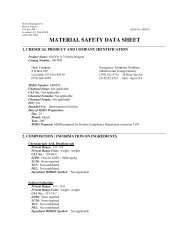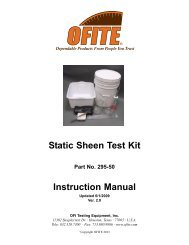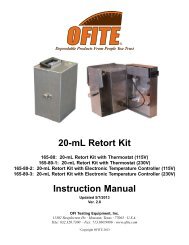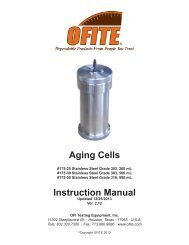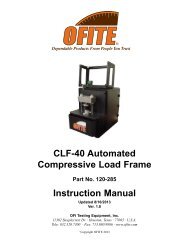Instructions - OFI Testing Equipment, Inc.
Instructions - OFI Testing Equipment, Inc.
Instructions - OFI Testing Equipment, Inc.
You also want an ePaper? Increase the reach of your titles
YUMPU automatically turns print PDFs into web optimized ePapers that Google loves.
<strong>OFI</strong> <strong>Testing</strong> <strong>Equipment</strong> – 146-00 <strong>Instructions</strong> – Workover and Completion Fluids Test Kit Page 16 of 17<br />
revolutions per minute. At this rate in 5 seconds the handle must be turned 10 times (120/60) (5). By counting the crank<br />
turns in 5 seconds and adjusting the rate to obtain the required number of turns, a constant 1800 revolutions per minute<br />
should be obtained in 15 to 20 seconds. The interval used to adjust to the 1800 revolutions per minute should be included<br />
in the centrifuge time of the sample.<br />
6. Clean the centrifuge tube immediately after use to facilitate ease of cleaning.<br />
7. Plot the volume of precipitate in milliliters versus pounds per barrel of KCl or milliliters of precipitate versus<br />
percent (%) potassium chloride using rectangular graph paper as shown below.<br />
Procedure - Sample <strong>Testing</strong><br />
1. Measure the appropriate volume of filtrate into the centrifuge tube. See the table below for the volume:<br />
Filtrate Volumes to Be Used At Various KCL Concentrations<br />
Concentration<br />
Filtrate Volume<br />
Range KCl K + to use<br />
(lb/bbl (mg/L) (ml)<br />
3.5 - 18 5,250 - 27,000 7.0<br />
18 - 35 27,000 - 52,500 3.5<br />
35 - 70 52,500 - 105,000 2.0<br />
over 70 over 105,000 1.0<br />
2. Dilute to 7.0 ml if necessary with distilled water in the tube and agitate the mixture.<br />
3. Add 3.0 ml of standard sodium perchlorate solution and do not agitate. If potassium is present precipitation<br />
occurs at once.<br />
4. Centrifuge at a constant speed of approximately 1800 rpm for one minute. Read the precipitate volume<br />
immediately and then record it.<br />
5. Add 2 to 3 drops of the sodium perchlorate solution to the tube. If a precipitate still forms, the total<br />
amount of potassium has not been measured. Refer to the table above and use the next smaller filtrate<br />
volume. Repeat the procedure in items 1 - 5 above.<br />
6. Determine the potassium chloride concentration by comparing the precipitate volume measured with the<br />
standard calibration curve as prepared above. Report the potassium concentration as pounds per barrel KCl.<br />
The potassium concentration may also be reported as milligrams per liter potassium ion. If the filtrate potassium<br />
chloride concentration from the standard calibration curve exceeds an 18 pounds per barrel reading, accuracy of<br />
the results is reduced. For more accurate results, use the next smaller filtrate volume as noted in the table above,<br />
and repeat the steps 1 through 5 above.<br />
Calculation:<br />
KCl in filtrate, lb/bbl = 7 ( Value from standard curve)<br />
<strong>OFI</strong>TE • 11302 Steeplecrest Dr. • Houston, TX 77065 USA • Phone (832) 320-7300 • http://www.ofite.com<br />
Version 1.1<br />
Date 03-04-03



